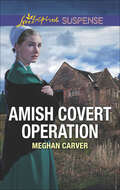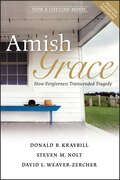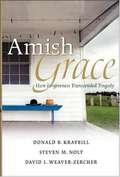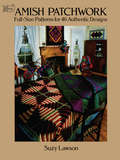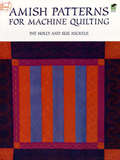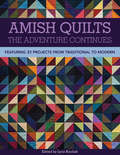- Table View
- List View
Amish Country Undercover
by Katy LeeAn FBI agent springs into action when an Amish woman’s life is in danger in this inspirational romantic suspense thriller.Taking the reins of her father’s Amish horse-trading business, Grace Miller’s prepared for backlash over breaking community norms—but not for sabotage. Now someone’s willing to do anything it takes to make sure she fails, and it’s undercover FBI agent Jack Kaufman’s mission to stop them. But can Jack face his own Amish past long enough to shield Grace from a killer?
Amish Covert Operation: An Anthology (Love Insp Susp True Lp Trade Ser.)
by Meghan CarverAn eyewitness to a crime, an Amish single mom goes under the protection of an undercover agent.After Amish widow Katie Schwartz’s search for her missing brother results in a shooting and her finding a cryptic message, she must rely on federal agent Adam Troyer to shield her. But, undercover as a Plain man, can Adam save her brother’s life and protect Katie? Trusting the handsome Englisch agent is already dangerous…but falling for him could risk everything Katie holds dear.
Amish Cradle Conspiracy (Amish Country Justice #13)
by Dana R. LynnFrom USA TODAY bestselling author Dana R. Lynn. To protect an Amish community… She&’ll make herself a target. After a pregnant Amish woman and her toddler are abducted, police sergeant Nicole Dawson charges in to save them. But when the kidnapper escapes with the child—and thinks Nicole can identify him—she becomes his new obsession. Determined to protect his ex-fiancée, FBI special agent Jack Quinn joins the case. But the clock is ticking in their race to uncover the baby-trafficking ring before another innocent is taken…From Love Inspired Suspense: Courage. Danger. Faith. AN AMISH COUNTRY JUSTICE THRILLER Book 1: Plain TargetBook 2: Plain RetributionBook 3: Amish Christmas AbductionBook 4: Amish Country AmbushBook 5: Amish Christmas EmergencyBook 6: Guarding the Amish MidwifeBook 7: Hidden in Amish CountryBook 8: Plain RefugeBook 9: Deadly Amish ReunionBook 10: Amish Country ThreatsBook 11: Covert Amish InvestigationBook 12: Amish Christmas EscapeBook 13: Amish Cradle Conspiracy
Amish Fugitive
by Shelley Shepard GrayAn Amish outcast. A woman willing to help.A killer determined to silence them. Daniel Miller&’s Amish community won&’t accept him even though he&’s been acquitted of a crime he didn&’t commit. When Lela Borntrager offers to help him find the real culprit, Daniel has a chance to prove his innocence. But a killer on the loose puts them both in danger. Will Daniel accept Lela&’s help, or will he sacrifice clearing his name to keep her safe?
Amish Garden: A Year In The Life Of An Amish Garden
by Laura A. LappAn Amish Garden: A Year in the Life of an Amish Garden takes you to six working Amish gardens, from January through December. Matchless photos show the garden asleep, the Amish women putting together their orders for seeds, the preparation of the soil, parents and children planting, the emerging plants, the lush harvest, the food being preserved. This close-up of a world seldom seen shows how the seasons and Amish life work rhythmically together. Laura Anne Lapp lives with her husband and three young sons in a tucked-away valley. Gardening is simply the highpoint of her year. Step apart and enter this pastoral world of hard work, sturdy families, the freshest of flowers and produce, all in harmony with the seasons.
Amish Generations: Four Stories
by Kathleen FullerFour sweet and funny Amish love stories, spanning four different generations. Love comes at all times and for all ages!Young Love—When Fern was diagnosed with a chronic illness in her early twenties, she knew it would limit her abilities to be a good Amish wife. And with Dan, the object of her affection, in a serious relationship, there didn&’t seem much point in dating. But Dan is now single, and he seems to be taking notice of Fern. She&’ll need a strong dose of courage to talk down the fear her illness has brought on if she ever wants to pursue her dreams.Long-Awaited Love—When Everett left ten years ago, Jemima&’s love quickly turned to hate. But when they arrive back home at the same bus station on the same day, they discover some old flames aren&’t put out so easily. Can they move past the forces that pulled them apart ten years ago, or are some hurts too much to overcome? Second-Chance Love—Benjamin and Lora Beth both lost spouses not long into their young marriages and connect over letters, exchanging recipes and commiseration as their now-grown children try to coddle them. They&’re only in their forties, for heaven&’s sake! The letters quickly reveal a deep friendship . . . or could it be more? When you&’ve already had a great love, how do you learn to fall in love again?Never Too Late—Jerald is a committed old bachelor. He loves nothing more than good Amish food and giving his best friend&’s wife, Regina, a hard time. When people have asked—and believe him, people have asked—he&’s always said he&’ll marry when he finds the right woman. It&’s just never happened in his seventy years. Until he tastes the best blueberry pie and discovers the woman behind it: Regina&’s best friend, Elva.
Amish Grace: How Forgiveness Transcended Tragedy
by Steven M. Nolt Donald B Kraybill David L Weaver-Zercher&“This intelligent, compassionate and hopeful book&” examines an Amish community&’s extraordinary response to a horrifying act of violence (Publisher&’s Weekly, starred review). On October 2, 2006, a gunman named Charles Roberts entered a one-room Amish school in Nickel Mines, Pennsylvania. He took ten schoolgirls hostage, killing five and critically wounding the others before taking his own life. To explain his motivation, he told the children, &“I&’m angry at God for taking my little daughter.&” By the following morning, as television crews swarmed the village, the Amish parents were already prepared to offer forgiveness. Soon, this extraordinary act of grace became a bigger story than the terrible crime that preceded it. Amish Grace explores the religious beliefs and habits that led the Amish to forgive so quickly. The authors examines the importance of forgiveness among cloistered communal societies and ask why this act of forgiveness became news among secular society. With insight and compassion, the authors contemplate how the Amish community&’s witness could prove useful to the rest of us.
Amish Grace: How Forgiveness Transcended Tragedy
by Steven M. Nolt Donald B. Kraybill David L. Weaver-ZercherOn Monday morning, October 2, 2006, a gunman entered a one-room Amish school in Nickel Mines, Pennsylvania. In front of twenty-five horrified pupils, thirty-two-year-old Charles Roberts ordered the boys and the teacher to leave. After tying the legs of the ten remaining girls, Roberts prepared to shoot them execution with an automatic rifle and four hundred rounds of ammunition that he brought for the task. The oldest hostage, a thirteen-year-old, begged Roberts to "shoot me first and let the little ones go." Refusing her offer, he opened fire on all of them, killing five and leaving the others critically wounded. He then shot himself as police stormed the building. His motivation? "I'm angry at God for taking my little daughter," he told the children before the massacre. The story captured the attention of broadcast and print media in the United States and around the world. By Tuesday morning some fifty television crews had clogged the small village of Nickel Mines, staying for five days until the killer and the killed were buried. The blood was barely dry on the schoolhouse floor when Amish parents brought words of forgiveness to the family of the one who had slain their children. The outside world was incredulous that such forgiveness could be offered so quickly for such a heinous crime. Of the hundreds of media queries that the authors received about the shooting, questions about forgiveness rose to the top. Forgiveness, in fact, eclipsed the tragic story, trumping the violence and arresting the world's attention.Within a week of the murders, Amish forgiveness was a central theme in more than 2,400 news stories around the world. The Washington Post, The New York Times, USA Today, Newsweek, NBC Nightly News, CBS Morning News, Larry King Live, Fox News, Oprah, and dozens of other media outlets heralded the forgiving Amish. From the Khaleej Times (United Arab Emirates) to Australian television, international media were opining on Amish forgiveness. Three weeks after the shooting, "Amish forgiveness" had appeared in 2,900 news stories worldwide and on 534,000 web sites. Fresh from the funerals where they had buried their own children, grieving Amish families accounted for half of the seventy-five people who attended the killer's burial. Roberts' widow was deeply moved by their presence as Amish families greeted her and her three children. The forgiveness went beyond talk and graveside presence: the Amish also supported a fund for the shooter's family. AMISH GRACE explores the many questions this story raises about the religious beliefs and habits that led the Amish to forgive so quickly. It looks at the ties between forgiveness and membership in a cloistered communal society and ask if Amish practices parallel or diverge from other religious and secular notions of forgiveness. It will also address the matter of why forgiveness became news. "All the religions teach it," mused an observer, "but no one does it like the Amish." Regardless of the cultural seedbed that nourished this story, the surprising act of Amish forgiveness begs for a deeper exploration. How could the Amish do this? What did this act mean to them? And how might their witness prove useful to the rest of us? (Proofreader's Note: Many resources in end matter. The index has also been proofread.)
Amish Haven: An Anthology (Amish Witness Protection #3)
by Dana R. LynnA Refuge for His FamilyAn Amish Witness Protection storyWhen criminal lawyer Tyler Everson witnesses his boss’s murder, he becomes the killer’s next target—along with his estranged wife, Annabelle, and their daughter. Now they must enter witness protection in Amish country. But reuniting with his family isn’t easy when Annabelle doesn’t trust him. Will going into hiding keep them safe…and bring the family back together for good?
Amish Hideout: Amish Hideout Wilderness Secrets Explosive Reunion (Amish Witness Protection #1)
by Maggie K. BlackShe must survive to testify…The first exciting Amish Witness Protection thriller!With a price on his witness’s head, US Marshal Jonathan Mast can think of only one place to hide Celeste Alexander—in the Amish community he left behind. As a computer expert, leading a life off the grid isn’t easy for Celeste. But will staying in Jonathan’s childhood home save her…and convince them a future together is worth fighting for?
Amish Holiday Vendetta
by Laura ScottFrom USA TODAY bestselling author Laura Scott... An Amish widow. An Englischer with a past. Who&’s the real target this Christmas? Attacked in her barn just before Christmas, Amish quilter Elizabeth Walton doesn&’t know why someone wants to harm her. But when gunfire narrowly misses Elizabeth and furniture maker David McKay, the Englischer fears his past has put them both in the crosshairs. David&’s determined to protect the pretty widow…but is his presence the real danger? Or is there another motive behind the deadly threats?From Love Inspired Suspense: Courage. Danger. Faith.
Amish Homecoming
by Jo Ann BrownThe Prodigal Daughter Returns Ten years ago, Amish quiltmaker Leah Beiler and her twin brother left their community and family without a word. Now she's finally come home-with her orphaned young niece. Leah has much to explain to so many, including Ezra Stoltzfus. Before she left, she dreamed of marrying the handsome dairy farmer. But now that she's lived among the English and is raising a child who knows nothing of Amish ways, Ezra worries she'll leave again. Leah will have to prove to Ezra that her future is in Paradise Springs-and with him-forever.
Amish Houses & Barns (People's Place Bks.)
by Stephen ScottA study of three Amish homesteads: one in Lancaster County, Pennsylvania, one in Holmes County, Ohio, and one in LaGrange County, Indiana. Scott examines the history and cultural development of a typical Amish house and barn, one in each of the three largest Amish communities in North America. Home is the center of Amish life and most life events:birth, marriage, daily work and play, retirement, and even death happen there. Stephen Scott explores the history and cultural development of three Amish homesteads, each of which has been occupied by the current family of residence for at least four generations. The Stoltzfus Farm of Lancaster County, Pennsylvania, the Yoder-Miller Farm of Holmes County, Ohio, the Bontrager-Miller Farm of LaGrange County, Indiana. Amish Houses and Barns also includes a photographic essay of typical Amish architecture in each of the three communities. Its numerous anecdotal stories,"Barn Fire," "The Farm Is Strip-Mined," and "Amish Style Graffiti", enhance the human story.
Amish Jane Doe
by Shelley Shepard GrayFormer sweethearts reunite while investigating murder in their Amish hometown in this inspirational romantic suspense from a New York Times bestseller.Escaping his Amish community as a teen was about survival, but leaving meant breaking LizBeth Troyer’s heart. Now Detective Jackson Lapp is working a cold case—and the clue to a murdered Amish girl’s identity leads him back to his hometown. Can Jackson and LizBeth rebuild their broken trust and work together to catch a killer before another young Amish woman is murdered?
Amish Love Letters
by Shelley Shepard Gray Charlotte Hubbard Rosalind LauerA heartfelt note, a loving message, a letter filled with secret hopes—this trio of sweet Amish romances will show that on Valentine&’s Day, the right words can spark a lifetime of joy.Love Letter Courtship * Shelley Shepard Gray After six months of courtship, Jennie Miller has refused Matt Lapp&’s proposal. Though he visits regularly, they never seem to talk deeply, and Jennie longs for real connection and romance. Chastened, Matt offers a solution. For two months, they&’ll share letters filled with their hopes and dreams. Soon, Jennie is falling for Matt in earnest . . . but will he ever propose again?S.W.A.K * Charlotte Hubbard Quiet, gentle Fannie Kurtz knows that fun-loving Eddie Brubaker is the man she wants to marry someday. When he starts receiving letters in pink envelopes, she realizes she has some competition. Maybe it&’s time she wrote a love note or two of her own? But a mix-up could jeopardize this romance before it starts, unless she keeps faith in Gott&’s plan . . . The Wrong Valentine * Rosalind Lauer Young widow Martha Lambright is grateful to be working at her mother-in-law&’s restaurant, even if seeing the kitchen gals giggle over Valentine cards gives her a pang. But when Mose Troyer, the former bad boy who drives Martha to and from work each day, finds a Valentine he mistakenly believes is for him, it begins a tender exchange that could lead to a wonderful future . . .
Amish Love Letters: Amish Winter Collection (Book Three)
by Samantha BayarrJoy's mother has been telling her for some time to stop playing hockey with the guys and end her rumspringa before she is too old to find a husband and have a family. Will a letter from a secret admirer change her mind about hockey and cause her to trade her hockey gear for dresses and dating?Jordan suddenly finds himself looking at his best friend, Joy, in a different way. Will Joy's secret admirer change their friendship forever?Find out in this bittersweet tale of love and friendship.
Amish Midwives: Three Stories
by Shelley Shepard Gray Amy Clipston Kelly LongFrom bestselling authors of Amish Fiction come three sweet stories about new life, hope, and romance. Bundles of Blessing by Amy ClipstonLost in grief after the death of her husband, Kristina Byler gave up remarrying and found comfort and purpose in becoming a midwife. She is surprised when Aidan Smoker—her ex-boyfriend and the man she was sure she&’d one day marry—moves back to the community after living in Ohio for the past eight years. They&’re both certain there&’s too much pain in their shared past for them to have a future, but they keep finding themselves drawn together. As Kristina helps other women bring children into the world, she starts to wonder if a family of her own might be possible after all.A Midwife for Susie by Shelley Shepard GrayHaunted by secret guilt after a tragic accident, Joanna Zimmerman is sure she&’s left midwifery behind her. She keeps to herself, certain this is for the best. Her childhood friend Dwight Eicher knows that Joanna hasn&’t been herself lately, but every time he&’s tried to talk to her about what&’s wrong, she&’s avoided his questions. When his sister, Susie, becomes pregnant, Joanna must decide if she can find the courage to return to the job she once felt so called to. Meanwhile, both Dwight and Joanna face romantic feelings that have the potential to change their friendship forever.Christmas Cradles by Kelly Long (Also in An Amish Christmas)When Anna Stolis takes over for her aunt, the local midwife, Christmas night heats up with multiple deliveries, three strangers' quilts, and unexpected help from the handsome and brooding Asa Lapp. Three sweet contemporary Amish romancesStand-alone novella collectionBook length: 80,000 wordsIncludes discussion questions for book clubs
Amish Outsider (River Haven #1)
by Marta PerryThe Amish of River Haven offer sanctuary and solace…even to those with a dangerous past.In the wake of his estranged wife’s murder, widower Michael Forster returns to the Amish community he’d left as a teen. He wants a fresh start for himself and his daughter, Allie, away from those who still believe he’s guilty. In River Haven, a quieter life seems possible. If only Allie’s Amish schoolteacher, Catherine Brandt, was easier to ignore.A problem solver by nature, Cathy can tell Allie’s withdrawn demeanor isn’t due to shyness. But getting through to Allie also means breaching her father’s hardened defenses. What starts as persistence soon grows into an attraction neither Cathy nor Michael saw coming. When the past suddenly threatens both his daughter and the woman he loves, Michael must risk everything to save them.
Amish Patchwork: Full-Size Patterns for 46 Authentic Designs (Dover Quilting)
by Suzy LawsonThis treasury of Amish patchwork artistry will introduce quilting enthusiasts to a wealth of traditional designs as ingenious as they are beautiful. Based on concepts and unwritten rules that have long governed Amish quiltmaking, most of these lovely patterns date from the late 1800s to the early 1930s.Ms. Lawson, a well-known quilt designer, first devotes a chapter to Amish color combinations, color suggestions, and possible decorative combinations. She then goes on to offer expert advice on borders, patterns, quilting, backing and binding, and more.Dimensions, full-size patterns, and over 100 black-and-white illustrations show how to make 48 beautiful Amish-style quilts, including such intriguing examples as "Botch Handle," "Hole in the Barn Door," "Sunshine and Shadow," and "Wild Goose Chase." In addition, you'll find patterns and instructions for creating such favorite quilting designs as teardrops, feathers, cables, stars, baskets, and floral and foliate motifs.Often spectacular, embodying an amazing diversity of patterns and combinations, Amish quilts are among the most sought-after of all quilting patterns. This book provides a comprehensive, inexpensive source of Amish quilt motifs geared to needleworkers at all levels of expertise.
Amish Patterns for Machine Quilting
by John W. Lee Pat HollyAn easy-to-follow guide translates traditional hand-quilted Amish designs into convenient sewing machine patterns. The 83 heirloom-quality designs -- including flowers, feathers, cables, baskets, stars, and more -- can be adapted in size, shape, or any other aspect. A brief history of the Amish, diagrams, and simple instructions are included.
Amish Pies: Traditional Fruit, Nut, Cream, Chocolate, and Custard Pies
by Laura Anne Lapp60 sweet and savory authentic Amish pies from a real Amish author! The Amish are known for their delicious baked goods and Amish author Laura Lapp has been making pies of all sorts since she was a child in their Lancaster area Amish community. Passed down from real Amish grandmothers, tattered recipe boxes, and old books and diaries, here is an assortment of delicious sweet and savory pies that have been and continue to be popular in eastern Pennsylvania, particularly in the Lancaster area. Now you too can enjoy the scrumptious pies of old order Amish cooks. Prepare to make wonderful treats such as: Shoofly Pie Apple Pie Fresh Peach Pie Lemon Sponge Pie Frozen Strawberry Pie Snitz Pie Oatmeal Pie Vanilla Pie Easy Peanut Butter Pie Sweet Potato Pie Chocolate Chip Cookie Pie Butterscotch Pie Chicken Pot Pie And more! These recipes will soon become your family favorites and go-to desserts for holidays, Sunday dinners, and potlucks. With simple ingredients and instructions that are easy to follow, you'll find yourself whipping up the same wonderful and comforting pies you'll find in Amish country.
Amish Protector (River Haven #2)
by Marta PerryIn River Haven, a mysterious visitor brings two lonely hearts together…Joanna Kohler treasures the independence her Amish quilt shop provides. She rarely leans on others, yet finding an injured woman on her property makes her grateful for the store owner next door, Noah Troyer. Calm and unflappable, Noah offers support. He also points out the strong resemblance between Joanna and the unconscious stranger…Noah may admire Joanna, but the bishop’s daughter is out of reach. Though he’s made a good life, Noah still feels shadowed by the shame his father brought on the community. But it’s his duty to aid his lovely neighbor, especially when danger draws close. As he and Joanna unearth answers about her past, Noah will have to confront his own if he’s to have a chance at building a future with the woman he’ll love forever.
Amish Quilting Patterns: 56 Full-Size Ready-to-Use Designs and Complete Instructions
by Joe Cunningham Gwen MarstonAuthentic Amish quilting patterns are among the most sough-after quilting styles today. Elegant and graceful, these eye-catching designs are widely recognized as a unique art form. Now with this useful guide, prepared by two noted quilt designers and teachers, needleworkers at all levels of expertise can re-create many popular Amish motifs passed down from generation to generation.Over 50 full-size, ready-to-use templates provide attractive designs for feathers, flowers, pinwheels, tulips, cables, pumpkin seeds, a star, and much more. Easy-to-follow instructions and numerous diagrams allow beginning as well as advanced quilters to undertake a variety of projects, while an informative introduction points out the differences between Lancaster County and Midwestern Amish styles.Useful for creating repeating borders, centers, corners, and overall patterns for full-size bedcovers, these classic designs can also be used individually to embellish pillows, cushions, and countless other domestic items.
Amish Quilts, The Adventure Continues: Featuring 21 Projects from Traditional to Modern
by Lynn KoolishThis volume features 21 Amish-inspired quilts by some of today's top quilt designers—with simple patterns showing off beautiful solid fabrics.Thirty years after Roberta Horton’s classic, An Amish Adventure, introduced quilters to the joys of Amish quilting, the editors at C&T Publishing are proud to bring you the adventure's next chapter. Along with the 21 featured quilt projects, this volume includes a gallery of 17 more beautiful quilts and an introduction by Roberta herself on what makes a quilt Amish.Some of the quilt projects in this volume use traditional 19th-century patterns. Others offer distinctly modern takes on Amish ideas. They all celebrate the simplicity, the bold geometry, and the rich dark fabrics that give Amish quilts their ageless appeal.
Amish Quilts: Crafting an American Icon (Young Center Books in Anabaptist and Pietist Studies)
by Janneken SmuckerThe definitive study on the history, meaning, art, and commerce of Amish quilts.Second Place Winner of the Design and Effectiveness Award of the Washington PublishersQuilts have become a cherished symbol of Amish craftsmanship and the beauty of the simple life. Country stores in Lancaster County, Pennsylvania, and other tourist regions display row after row of handcrafted quilts. In luxury homes, office buildings, and museums, the quilts have been preserved and displayed as priceless artifacts. They are even pictured on collectible stamps. Amish Quilts explores how these objects evolved from practical bed linens into contemporary art.In this in-depth study, illustrated with more than 100 stunning color photographs, Janneken Smucker discusses what makes an Amish quilt Amish. She examines the value of quilts to those who have made, bought, sold, exhibited, and preserved them and how that value changes as a quilt travels from Amish hands to marketplace to consumers. A fifth-generation Mennonite quiltmaker herself, Smucker traces the history of Amish quilts from their use in the late nineteenth century to their sale in the lucrative business practices of today. Through her own observations as well as oral histories, newspaper accounts, ephemera, and other archival sources, she seeks to understand how the term "Amish" became a style and what it means to both quiltmakers and consumers. She also looks at how quilts influence fashion and raises issues of authenticity of quilts in the marketplace.Whether considered as art, craft, or commodity, Amish quilts reflect the intersections of consumerism and connoisseurship, religion and commerce, nostalgia and aesthetics. By thoroughly examining all of these aspects, Amish Quilts is an essential resource for anyone interested in the history of these beautiful works.

